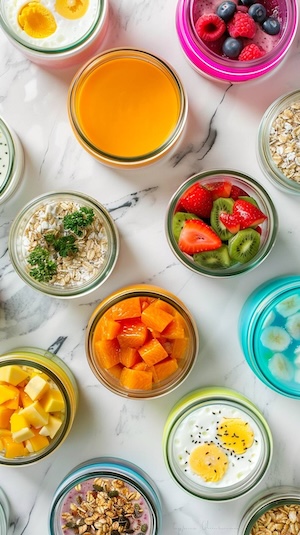PCOS for Picky Eaters: 30 Simple Meal Ideas
Discover 30 simple pcos meals for picky eaters that help manage symptoms. Easy pcos meals picky eaters will love, with practical tips and hormone-balancing ingredients.
This recipe includes superfoods such as:
Transform your health with tailored 7-day meal plans designed specifically for PCOS management. Just $7/month or $59/year.
Get it now →1 1/2 cups dried chickpeas
1 tablespoon baking soda
1 cup tahini, well stirred
5 tablespoons lemon juice (about 3 lemons)
1 1/2 teaspoons kosher salt
4 cloves garlic, crushed with salt
3/4 cup ice water
For the hummus: Spread the chickpeas out on a baking sheet and comb through to rid them of pebbles, little clumps of earth-anything that is not a chickpea. Wash well in several changes of water, and drain. Transfer to a large bowl with 4 cups water. Stir in the baking soda and let the chickpeas soak overnight, at least 12 hours and up to 24 hours. Drain the chickpeas and wash in a couple changes of fresh water to rinse off the now-soapy soaking liquid. Bring the chickpeas and 6 cups water to a boil in a medium saucepan over medium-high heat. Boil for 2 or 3 minutes, then reduce the heat to low and gently simmer, uncovered, until the chickpeas are very soft, verging on mushy, about 40 minutes. Start checking for doneness at the 30 minute mark. Thanks to their baking soda bath, the chickpeas will throw off copious amounts of foam during cooking. Skim, skim, and keep skimming. You'll want to remove as much foam as possible. Drain the chickpeas, transfer to a food processor, and process into a smooth paste, scraping down the bowl with a rubber spatula as needed. With the machine running, add the tahini, lemon juice, salt and garlic. Give them a minute to whirl about, and then slowly drizzle in the ice water. Process for at least 5 minutes, and feel free to process longer. This final stage is absolutely key to getting the smooth, creamy, whipped quality you're looking for. At this stage, the hummus will be quite warm and considerably looser than you are probably accustomed to. Do not worry; these are signs of good things to come. Taste for seasoning and acid balance, and add more salt, lemon or tahini to taste. You're looking for an equilibrium, such that the mixture doesn't so much taste of garlic, or tahini, or even chickpeas; it tastes of hummus, a thing far greater than the sum of its parts. For the tahini sauce: Combine 1/3 cup water, the tahini, lemon juice and a couple pinches salt in a small bowl, and beat with a fork to blend. The mixture will thicken dramatically. Thin with more water, as needed. The sauce should have the consistency of heavy cream. Beat in the lemon zest. For assembly: Spoon 3 or 4 large dollops of hummus into a wide, shallow bowl (a pasta dish is ideal). Spread the hummus in an even layer across the base of the bowl by rotating it around the back of a serving spoon, leaving a well in the center of the hummus. Pour a liberal amount of olive oil around the edges, enough to form a sort of green moat. Drizzle 1 or 2 tablespoons of the tahini sauce over the hummus. Sprinkle with healthy pinches of cumin, paprika and chopped parsley. Serve with warm pita and pickles.

You know the drill: Alarm goes off. You hit snooze. Rush around frantically. Skip breakfast AGAIN because there's no time. By 10am, you're hangry, your blood sugar is all over the place, and your PCOS symptoms are already acting up.
Sound familiar?
Finally – a meal prep system designed specifically for women with PCOS who refuse to let chaotic mornings derail their health goals.
In just ONE hour on Sunday, you can transform your entire week:
"I went from skipping breakfast 4 days a week to having delicious, hormone-supporting meals ready every morning. My energy is more stable and my cravings have disappeared!"
– Sarah M.
Stop letting chaotic mornings control your health.
Get your hormone-happy mornings starting this Sunday.
→ Get Your 60-Minute Solution Now
Transform your health with tailored 7-day meal plans designed specifically for PCOS management. Just $7/month or $59/year.
Get it now →Serving Size: 1
| Amount Per ONE Serving | ||
|---|---|---|
| Calories 0 kcal | ||
| Fat 0 g | ||
| Carbohydrate 0 g | ||
| Protein 0 g | ||
💡 Introducing the 10/10 PCOS Solution:
Ten Delicious Crockpot Recipes that take just 10 minutes to prep!
Say goodbye to hours in the kitchen and hello to clean, PCOS-friendly meals made effortlessly.
👉 Click here to grab your 10/10 PCOS Solution today! Try The 10/10 PCOS Solution: Ten Crockpot Recipes That Take Just Ten Minutes to Prep
Managing PCOS can be challenging, but you don't have to do it alone. Join our supportive community to connect with others who understand what you're going through, share tips, and get encouragement. Here's how you can get involved:
Subscribe to our Newsletter: Receive PCOS-friendly recipes, tips, research updates, and more delivered straight to your inbox. Stay informed and empowered with the latest information and support.
Join our Telegram Channel: Stay updated with the latest tips and advice on managing PCOS.
Follow PCOS Meal Planner on Facebook: Engage with our community, participate in discussions, and get support from others.
Break the cycle with the PCOS Meal Planner - your personalized guide to eating better, feeling better, and managing PCOS symptoms. Take control today!

Forget the frustrating cycle of weight loss attempts, endless medications, and living in discomfort. Introducing the PCOS Meal Planner. A meal planning guide that goes beyond temporary fixes to offer a comprehensive strategy, empowering you to ignite a transformation towards lasting health and happiness. Step into a world where you control your PCOS, not the other way around.
Unlock Your PCOS Freedom Now.
Discover 30 simple pcos meals for picky eaters that help manage symptoms. Easy pcos meals picky eaters will love, with practical tips and hormone-balancing ingredients.
Discover 15 delicious overnight oats for PCOS recipes that help balance hormones and manage symptoms. Easy, nutritious breakfast ideas perfect for women with PCOS.
Discover the best cereal for PCOS with our expert rankings. Compare brands, check ingredients, and find PCOS friendly cereal that supports hormonal balance.
Learn how to transition away from fruit when starting a ketogenic diet for PCOS. Discover gradual strategies, fruit alternatives, and practical tips for success.
Discover 5 delicious PCOS banana bread recipes with low-glycemic ingredients. Learn how to make hormone-friendly banana bread that supports blood sugar balance.
Creatine for women with PCOS explained simply. Learn safety, benefits, hormone effects, tips, and how creatine may support PCOS symptoms naturally.
Complete PCOS diet plan with foods to eat, foods to avoid, meal timing, and real results. Learn the science-backed approach to managing PCOS through diet, with 7-day meal plan, grocery list, and step-by-step implementation guide. Based on clinical research and real patient outcomes.
Complete guide to ordering at Wendy's with PCOS. Discover the best protein-focused meals, what to skip, and how to customize orders to keep blood sugar stable. Learn which burgers, salads, and sides work for PCOS, plus complete macros for every menu item and smart swaps to avoid insulin spikes.
Complete guide to ordering at Burger King with PCOS. Discover the best protein-focused meals, what to skip, and how to customize orders to keep blood sugar stable. Learn which burgers, salads, and sides work for PCOS, plus complete macros for every menu item and smart swaps to avoid insulin spikes.